Platyhelminthes
1/45
There's no tags or description
Looks like no tags are added yet.
Name | Mastery | Learn | Test | Matching | Spaced |
|---|
No study sessions yet.
46 Terms
What type of symmetry do Platyhelminthes exhibit?
Bilateral — primitive form
What type of body complexity do Platy have?
Triploblastic acoelomates
What germ layers are included in triploblastic individuals
Mesoderm
Endoderm
Ectoderm
What simple functions do Platy lack?
Circulatory and respiratory organs
What are two unique organs at the complexity of Platy?
Blind gut and brain
Define blind gut
The mouth and anus are the same
Are Platy segmented or unsegmented?
Can be either
Where do Platyhelminthes live?
Some free living, some parasitic
What are the three classes of Platyhelminthes and what organisms are found in them?
Turbellaria:
All free living
Most are marine, but some are freshwater and terrestrial
Planaria
Tremetoda:
Parasitic flukes
Cestoda:
Tape worms
What individuals does Turbellaria include?
All sub-groups of Platyhelminthes that are not parasitic
Some living in fresh water, some in marine habitats
Most are predators
How many species in Turbellaria and how large are they
About 4,500 species
Most are small — around 1mm
Some get up to 25in — in which case they become ribbon shaped
How does Turbellaria reproduce?
All reproduce sexually
Most are hermaphroditic
Larvae look like ciliated planula
What are neoblast cells and what are they found in?
They allow for regeneration
Turbellaria
How does Turbellaria respire?
Diffuse oxygen throughout their body
What type of digestive organ does Turbellaria have?
Blind pockets with branches — help in digestion and transfer of nutrients throughout the body
Explain excretion in Turbellaria
Flame cells form on each side of the stomach
Get rid of metabolic waste
Protonephrida - collection of flame cells
How does Turbellaria balance internal water levels?
Small pores on the epidermis open to allow water in and out
How do Turbellaria “see”/sense?
Use eye spots for light, which contain statocysts for balance
Explain transportation in Turbellaria
Cilia on bottom of the organism
What type of muscles do Turbellaria have and what do they do?
Circular: outermost muscles which elongate body
Longitudinal: right underneath circular muscles - shorten body
Diagonal: have more specific, complex responses - can flatten body
Explain Turbellarian reproduction?
Most are hermaphroditic and produce few large eggs
Separate sexes are rare
Have many elaborate reproductive methods: penis fencing
Explain penis fencing
Turbellaria use two-pronged penis to try to stab each other
Anywhere on the body that is stabbed, sperm is deposited
It is not an advantage to be pregnant (due to energy expenditure), so they must fight for fatherhood.
Name the 5 main orders of Turbellaria and what types of organisms these orders encompass:
Acoela
No gut cavity —> have cells with digestive capabilities
Rhabdocoela
Simple tubular gut
Allocoela
gut has one main branch with more complex pharynx
Trocladia
Triclad gut
many species, including Planaria — successful
Polycladia
Branched gut
most marine
Also successful

Name the class and the letters of the body plan
Turbellaria - Planaria
A. Eye spots
B. Gastrovascular cavity
C. Ventral nerve cord
D. Mouth
E. Pharynx
F. Protonephridium
G. Brain
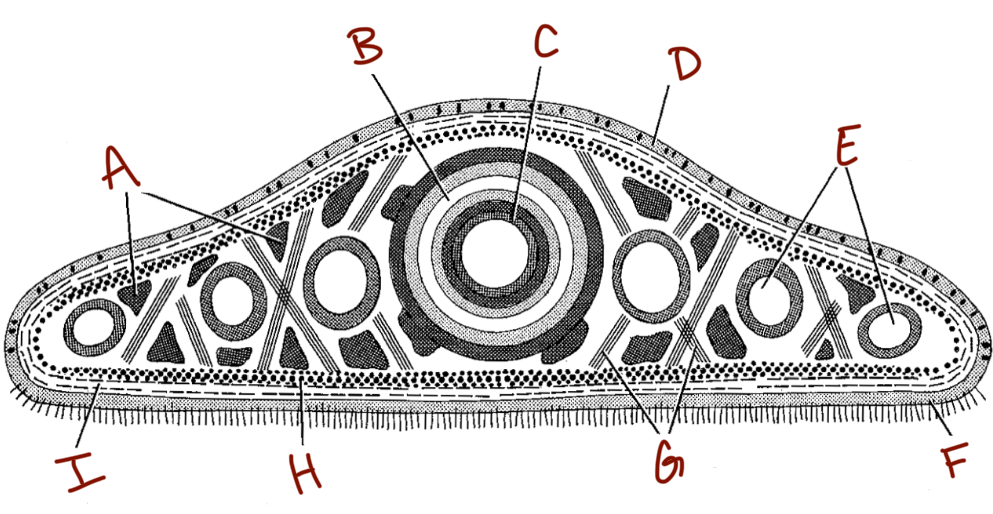
Name the class and label
Turbellaria - Planaria
A. Mesodermal parenchyma
B. Proboscis cavity
C. Proboscis
D. Proboscis dorsal epidermis (with rhadbites)
E. Gut branches
F. Ciliated ventral epidermis
G. Diagonal muscles
H. Inner longitudinal muslces
I. Outer circular muscle
What individuals does Tremetoda include?
Parasitic flukes
contain oral suckers
18,000-24,000 species
What is the body plan for Tremetoda?
Essentially the same as Turbellaria but without cilia
What type of eggs do Tremetoda create?
Large groups of small eggs
What is the main goal for parasitic organisms?
To not be found by the host — remain hidden and reproduce as much as possible
Usually do not have pathogenic effect on host
What are some parasitic adaptations that Tremetoda and Cestoda have?
Reduced sense organs - no eye spots
Reduced locomotion - no cilia
Reduction/loss of ability to maintain homeostasis
Elaborate/complex lifecycle - usually with multiple hosts and can sexually and can asexually reproduce at various parts of maturity
Organs of attachment
High reproductive capacity
Explain the characteristics of subclass Monogenea
Phylum: Platyhelminthes
Class: Tremetoda
Ectoparasites: live on outside of the host body
Usually hosts on lower vertebrates like fish and amphibians
Commonly found on skin, gills, and fins
Very simple life cycle
No intermediate host
eggs develop into adult
Causes fish to be lethargic, gulp for air, and try to scrape parasites off.
Explain Monogenea lifecycle
Phylum: Platyhelminthes
Class: Tremetoda
Subclass: Monogenea
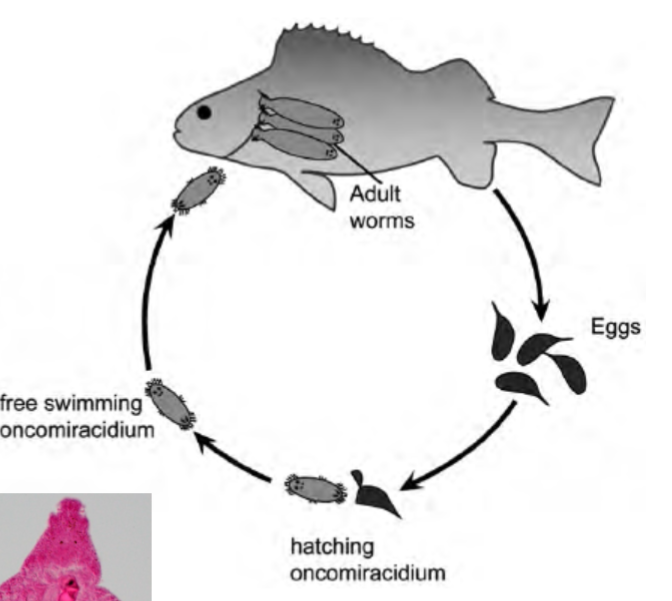
Briefly explain subclass Digenia
Phylum: Platyhelminthes
Class: Tremetoda
Endoparasites: parasite is inside the host
Have at least 2 hosts
Primary hosts: where it reaches sexual maturity and sexually reproduces
Intermediate host: where asexual reproduction occurs
Explain Digenia body plan
Relatively simple gut
Complex hermaphroditic genitalia
Ventral sucker to attach to host
Male pore with sperm duct
Female pore with uterus and ovary
Explain the maturation steps that Digenia goes through within an intermediate host
Eggs enter intermediate host
Eggs hatch into miricidium
Miricidium develops into sporocyst
Sporocyst asexually reproduces redia
Redia develop into cercaria
Name the subclass and label
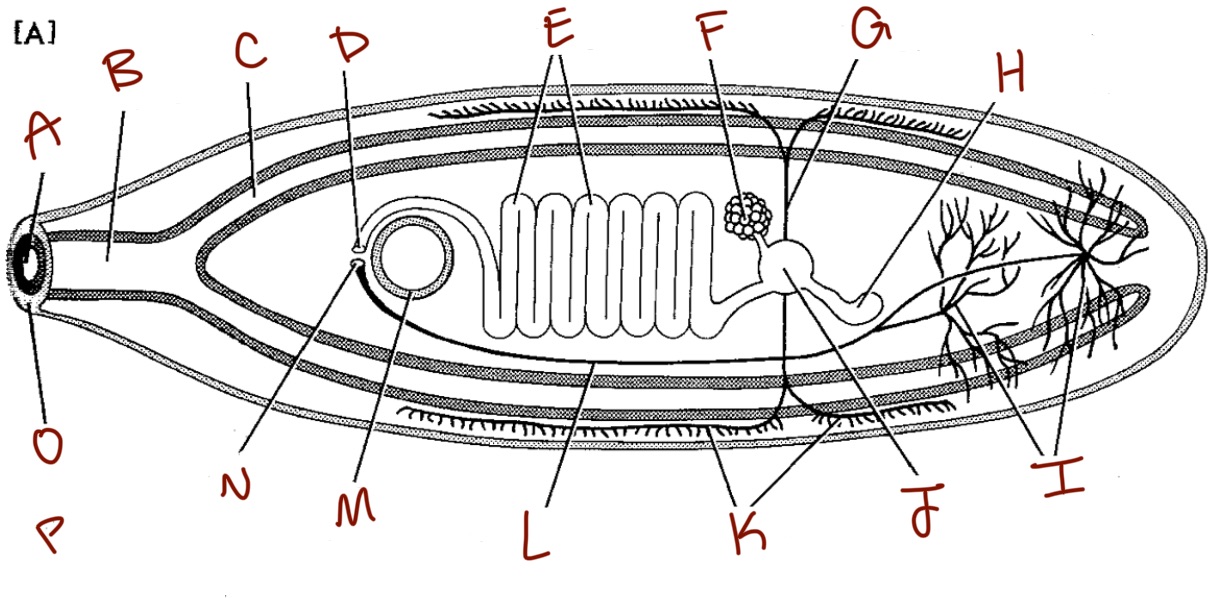
Phylum: Platyhelminthes, Class: Tremetoda, Subclass: Digenia
A. Mouth
B. Pharynx
C. Gut
D. Female pore
E. Uterus
F. Ovary
G. Yolk duct
H. Seminal receptacle
I. Testes
J. Shell gland
K. Yolk gland
L. Sperm duct
M. Ventral sucker
N. Male pore
O. Oral sucker
P. enelope is Digenia
Describe the life cycle of Clonorchis sinensis
Phylum: Platyhelminthes
Class: Tremetoda
Subclass: Digenia

Describe the characteristics of sheep flukes - Fascicola hepatica
Phylum: Platy
Class: Tremetoda
Subclass: Digenia
Species: Fascicola sp. (hepatica)
Common definite primary hosts are humans and ruminants
Encyst on grass tips
The snail intermediate host can pick up the egg or miracidium
Wider distribution than Clonorchis
Adult flukes travel to bile duct and feed on bile
Describe Fascicola hepatica lifecycle
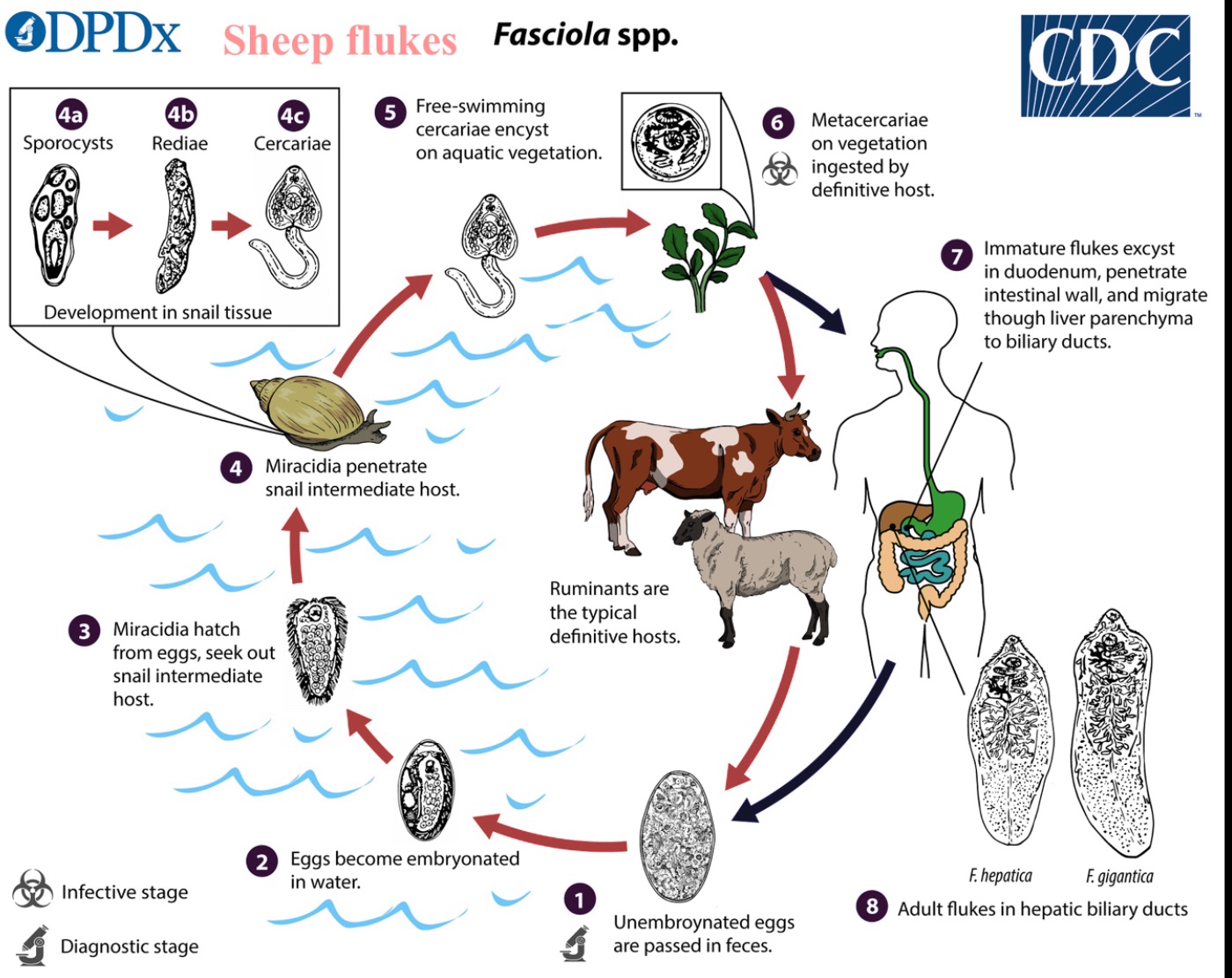
Phylum: Platy
Class: Tremetoda
Subclass: Digenia
Species: Fascicola sp. (hepatica)
Describe the overall characteristics of blood flukes - Schistisoma spp.
Phylum: Platy
Class: Tremetoda
Subclass: Digenia
Species: Schistisoma spp.
Eggs hatch into miracidium before or during intermediate snail phase
Cercaria has a forked tail
Blood flukes only use mammals as primary hosts and only use snails as secondary hosts - no other hosts
Cercaria penetrate skin of human in or near water and absorb its tail for nutrients
Describe the Schistisoma body plan
Phylum: Platy
Class: Tremetoda
Subclass: Digenia
Species: Schistisoma spp.

Explain the subclasses of Cestoda
Cestoda - tapeworms
6,000ish species - all parasitic
Subclass: Cestodaria
Unsegmented
Subclass: Eucestoda
Segmented
Describe basic eucestoda body plan
Phylum: Platy
Class: Cestoda
Subclass: Eucestoda
Scolex (head)
Proglottid - segmented individuals with female and male reproductive organs that can produce 50-100 eggs
No gut - endoparasite of hind gut and just absorbs you
Describe the lifecycle of Taenia
Phylum: Platy
Class: Cestoda
Subclass: Eucestoda
Genus: Taenia (pissiformis) - beef and pork tapeworms
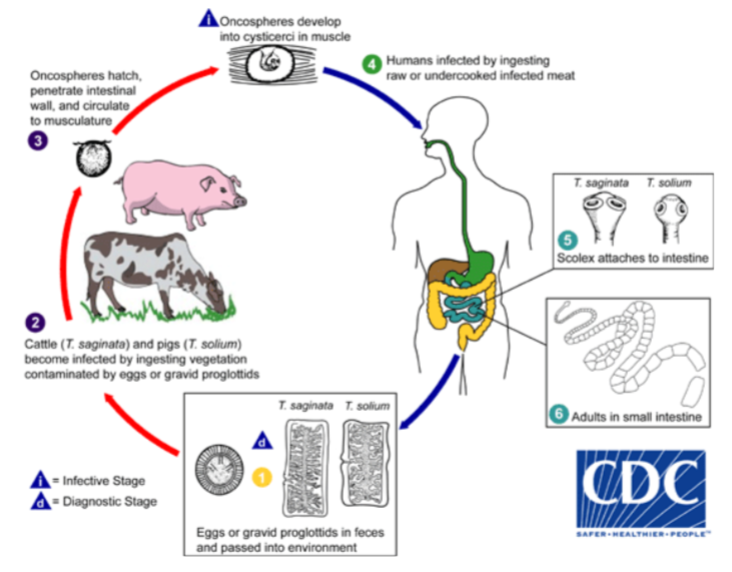
Describe the lifecycle of Echinococcosis
Phylum: Platy
Class: Cestoda
Subclass: Eucestoda
Genus: Echinococcosis - dog tapeworm
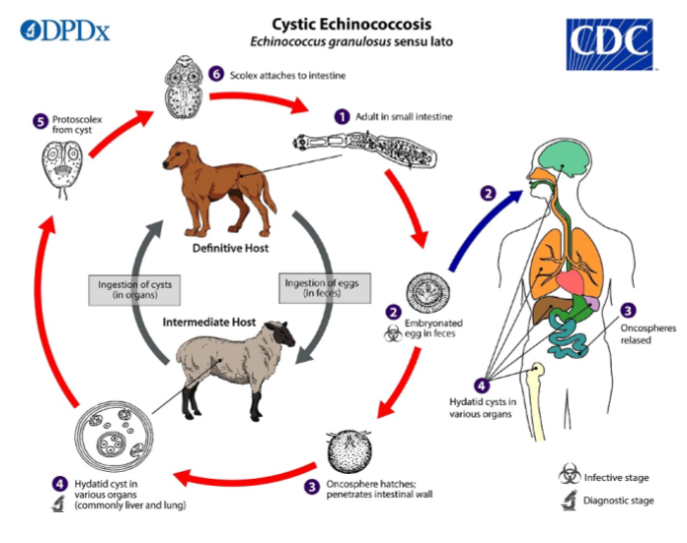
What are larval Eucestoda called?
Bladder worms